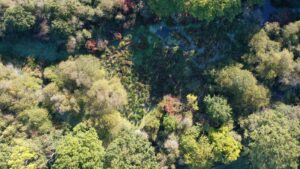
Knepp’s 2025 in numbers
knepp’s 2025 in numbers 2025 has been quite a year. Our butterfly summer was record-breaking, we re-launched the Knepp Wilding Podcast with Isabella Tree as
Home / White storks’ revival: what happens when we stop asking ‘why’ and start asking ‘why not’

Matt Phelps | Lead Ecologist
Published May 2025
This spring, a piece of history is being written in Sussex as we witness another successful breeding season for white storks, thanks to the efforts of the White Stork Project – a collaboration between Cotswold Wildlife Park, the Roy Dennis Wildlife Foundation, Knepp Wildland Foundation and Wadhurst Park Estate in East Sussex.
Seeing white stork chicks emerge in the wild in Britain for the first time in centuries is more than just a wildlife success story. They are a symbol of what’s possible when we take nature recovery seriously – and a reminder of how fragile that recovery still is. This year, EuroNatur – the European Environment Agency – has recognised this achievement by naming Knepp jointly with our local village Storrington as a European Stork Village, joining 15 other official stork villages in 15 other countries across the continent. For Storrington, whose name was originally ‘Estorcheton’ – old English for ‘Abode of Storks’ – it’s a home-coming, a hope that one day storks might be nesting on rooftops once again. On 5 May, the town will host the inaugural White Stork and Nature Revival Festival – a day to celebrate the bird that is renowned throughout Europe as the bringer of new life.
As the white storks bill-clatter on their nests with their great red bills, and glide on thermals between the tops of Knepp’s oaks on their powerful black and white wings, they seem to evoke something larger than life, something prehistoric. Yet, their return wasn’t inevitable. It wasn’t just a matter of time; it was a matter of will. And while they are now established as a breeding species here in Sussex, the work to ensure their future – and the future of so many other species – has only just begun.
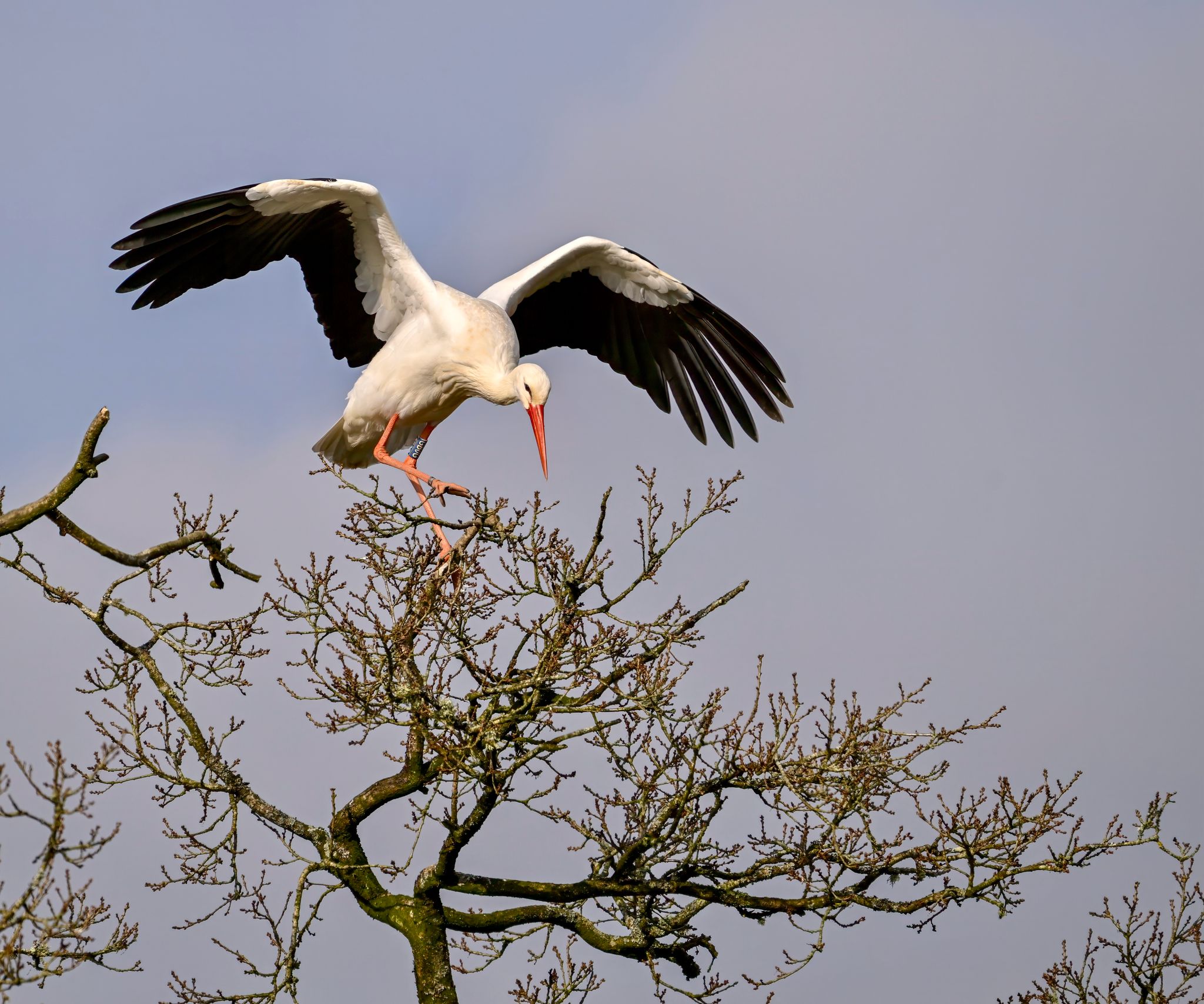
For years, the idea of reintroducing white storks seemed out of reach. The challenges for reintroductions and translocations of any species in Britain are considerable – largely because of the culture of risk aversion that has settled into our conservation organisations, the very bodies that should be most concerned about restoring lost and vulnerable species. Reintroductions are hugely popular with the public. A YouGov poll in 2020 found that 82% of Britons want to see extinct species back. 64% would bring back spoonbills and Dalmatian pelicans; even more – 68% – would like to see new populations of raptors such as goshawks, ospreys and white-tailed eagles. 62% want to see beavers at large in our countryside; and 36% would even vote for wolves and lynxes. Yet despite this overwhelming public desire for positive action to restore missing wildlife to Britain, far too often, the ambition is left to tiny nature charities and philanthropists to carry forward. Every introduction success is therefore not just a win for nature and the great majority of us who want to have these creatures back, but another flagship to show the recalcitrant world of institutionalised ‘conservation’ how it can be done.
The White Stork Project was originally the idea of reintroduction experts Roy Dennis – famous for his successful reintroductions of ospreys and white-tailed eagles to Britain – and Derek Gow, champion of beavers, wildcats and water voles. It was inspired by stork reintroduction programmes in Europe including in Alsace and Sweden and was finally given the green light by the UK government’s Department for Environment, Food and Rural Affairs (DEFRA), in 2016.
The founding birds of Knepp’s colony are a group of non-flying white storks from Poland, donated by Warsaw Zoo, rehabilitated following accidents with powerlines and roads. Some of these Polish birds are also kept at Cotswold Wildlife Park, to breed more birds for release at Knepp, and at Wadhurst Park in East Sussex.
Not only does this offer a second chance to injured birds, but the ground-nesting colony acts as a magnet for wild white storks prospecting over Britain from Europe. As highly social creatures, they only settle where other white storks are already nesting. There is safety in numbers. A strong colony can protect eggs and chicks from predation by crows, rooks, red kites and other raptors.
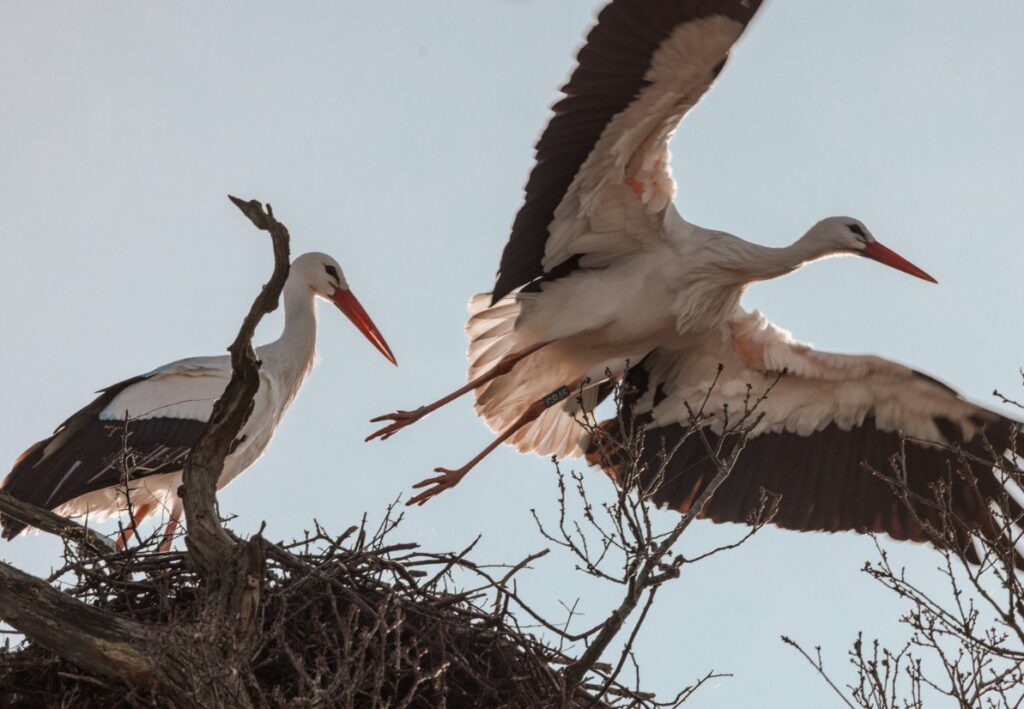
In the wild, storks nest on the tops of trees or roofs in villages and towns, safe from the clutches of foxes, cats and dogs. But at Knepp, Wadhurst and Cotswold Wildlife Park, in the safety of their pens, the non-flying storks are now breeding on the ground. One day, their chicks will fly and join the wild stork population. This year at Knepp we have eight ground nests harbouring 26 eggs. In total across Knepp, including our tree nests, we have 23 nests, holding 86 eggs, of which a handful have already hatched. In 2024, 53 chicks fledged and this year we seem to be on track for a similar number again. At Wadhurst, there are four nests containing ten eggs.
Now, five years after our first chicks fledged, the story is coming full circle. This year, we have welcomed home five storks who fledged from Knepp, spent several years in warmer climes, and have now returned as adults to Knepp to breed. They are currently sitting on nests incubating eggs. We watch daily to see if any of Knepp’s second generation have hatched yet. This happened for the first time in 2023 when one such stork returned to breed. We hope next year there will be more still.
The success of the project has already gone beyond our wildest dreams. We’re learning more about these birds every year, systematically recording their movements – including the 10 or so young birds we GPS tag every summer so we can follow them on migration, monitoring their social interactions and breeding success, comparing notes with colleagues in Morocco, Spain, Portugal, Sweden, Poland and France. This data is opening up whole new worlds about storks to science, creating strategies that will help their long-term conservation across their entire range. We’re also digging into the ecology here at home, working with the Natural History Museum to identify the species of insects that inhabit stork nests, and the other birds, such as house sparrows and collared doves, that choose to nest in stork nests too.
Tens of thousands of people now visit Knepp every year, primarily to see the storks. We have 40 volunteers maintaining our pen, feeding our rehabilitated birds and monitoring our free-flying population. Our live webcam on a stork nest in the top of one of our oak trees is watched by thousands of viewers, and screened around the clock into nursing homes, hospitals and schools.
For us, though, the storks’ return is not just about storks – it’s a call to action to the government and conservation organisations to get braver and be bolder about reintroductions, a rallying cry for all the other species waiting to demonstrate the benefits they can bring to our ecosystems and ourselves.
Come and see Knepp for yourself. Find out What’s On.

knepp’s 2025 in numbers 2025 has been quite a year. Our butterfly summer was record-breaking, we re-launched the Knepp Wilding Podcast with Isabella Tree as
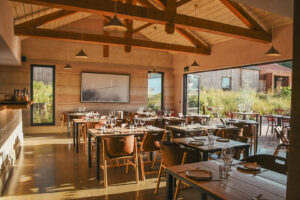
Knepp Wilding Kitchen- Restaurant Supervisor Job Description We are looking for a dynamic, enthusiastic and experienced front-of-house professional looking for a new challenge and to
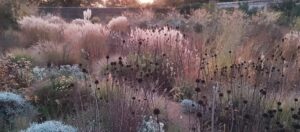
Moy Fierheller | Deputy Head Gardener Published December 2025 Visit Knepp’s rewilded Walled Garden November begins with warmth and rain. The remnants of Hurricane Melissa that caused tragedy and catastrophic
Knepp Wildland Safaris, our gardens and campsite are all about the quiet and patient observation of nature.
Some of the species we are likely to encounter are shy or can be frightened by loud noises or sudden movements. Our campsite with open-air fire-pits, wood-burning stoves and an on-site pond is unsuitable for small children.
For this reason, our safaris, garden visits, holiday cottages and campsite are suitable only for children of 12 and over.
You’ll receive relevant offers and news by email. This will include information about the Rewilding Project, online store products, the Wilding Kitchen Restaurant / Cafe, and other exciting experiences / events across the Knepp Castle Estate. For more information, view our Privacy Policy.